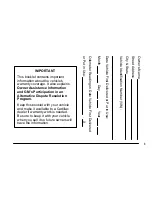
392
SERVICING AND MAINTENANCE
Dual Rear Wheels
Tire Rotation
The tires used on dual wheel assemblies should be
matched for wear to prevent overloading one tire in
a set. To check if tires are even, lay a straight edge
across all four tires. The straight edge should touch
all the tires.
NOTE:
If your vehicle is equipped with a Tire Pressure
Information System (TPIS):
The Tire Pressure Information System (TPIS)
uses unique sensors in the inner rear wheels to
help identify them from the outer rear wheels,
because of this, the inner and outer wheel loca
-
tions can’t be switched.
After a tire rotation is completed, as shown
below, the system can auto learn the locations
of each sensor ID. Auto learning/localization
occurs when the vehicle ignition status is
changed from Off to On and speeds of greater
than 5 mph (8 km/h) are obtained and remain
over 5 mph (8 km/h) for at about a 15 minute
period. You may need to drive for 20 minutes to
account slower speeds and stops.
If the tires are rotated incorrectly, the Auto local
-
ization of the TPIS sensors will fail to locate
correctly resulting in incorrect locations for the
pressure values displayed in the Instrument
Cluster.
DEPARTMENT OF TRANSPORTATION
UNIFORM TIRE QUALITY GRADES
The following tire grading categories
were established by the National
Highway Traffic Safety Administration.
The specific grade rating assigned by the
tire's manufacturer in each category is
shown on the sidewall of the tires on
your vehicle.
All passenger vehicle tires must conform
to Federal safety requirements in
addition to these grades.
T
READWEAR
The Treadwear grade is a comparative
rating, based on the wear rate of the tire
when tested under controlled conditions
on a specified government test course.
For example, a tire graded 150 would
wear one and one-half times as well on
the government course as a tire graded
100. The relative performance of tires
depends upon the actual conditions of
their use, however, and may depart
significantly from the norm due to
CAUTION!
4500/5500 Dual Rear Tires may only have
one approved direction of rotation. This is to
accommodate the asymmetrical design (tread
pattern) of the On/Off road tire.
When replacing a flat, the spare tire may have
to be remounted on the rim or installed at a
different location to maintain the correct
placement of the tire on the wheel relative to
the tire/wheel position on the vehicle. For
example, if the spare is used to replace an
outer rear tire it will have to be remounted on
the rim so that the wheel is dished inward.
That way the tread design of asymmetrical
tires will maintain proper position.
22_DPF_OM_EN_USC_t.book Page 392
















































